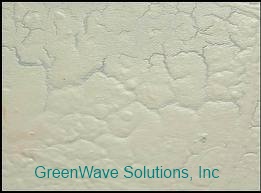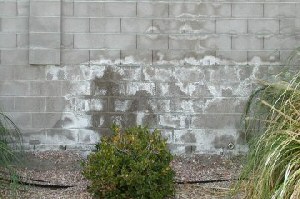What is Mud Cracking
Have you ever done painting or drywall repair work and everything looked good when you were done, but upon returning the next day you were greeted with cracks (like in the picture above)?
This is called mud cracking. It gets this name because it so closely resembles the cracking mud in a desert or dry river bed. Ironically, the scientific cause is the same for both occurrences.
The cause for mud cracking is applying to thick a coat of paint, drywall mud, etc. When you apply a coating at a milage rate that is thicker than for what it was designed, it causes problems as it dries. Drying is the simple process of moisture leaving the coating. When a coat is too thick, the outside layer that is exposed to air begins to harden as moisture is still trying to escape from the inside. The escaping moisture causes the outside layer to expand and crack. When the moisture get out, this outside layer contracts back to its original size, but the cracking can’t be undone.
Mud cracking is more prevalent in coatings that dry hard with little flexibility like drywall mud and enamels.
How do you avoid mud cracking?
Preventing mud cracking is the easiest strategy. Be patient. If the paint isn’t changing the wall color with one “normal” coat, then you are going to have to do another coat. Trying to pile it on the wall so heavy isn’t going to magically help the paint’s hide. It will only leave a sloppy, uneven, finish with a high probability for mud cracking. The same goes for trying to use drywall mud to fix large, deep holes.
I know that us men don’t like reading instructions, but being a real man includes knowing when you don’t know stuff. It’s like the old cliche` of asking for directions. I’d rather stop, ask for help, save my time, gas, and stress instead of proving that I’m a “real man” by driving around like a moron for hours. Also guys, I don’t care if you painted when you were in college 30 years ago. Just like computers, phones, and cars, technology has also changed paint products. Read the directions!
How do you fix mud cracking?
Okay. So someone didn’t follow directions and the mud cracking has already happened. Here’s how you fix it.
Sand it smooth and touch up where necessary. This can be more difficult than it sounds. Drywall mud is pretty easy because it is made to be sanded, however, if you are using an industrial enamel that is designed to be hard as metal, get your power sander ready. Also, wear safety glasses and dust masks when you sand this stuff. Breathing all of that crap is bad for you.
I hope that this has answered any questions you have about mud cracking. Feel free to email us if you need any help.
President of GreenWave Solutions, Atlanta painting company and Dunwoody house painters. GreenWave Solutions offers painter services in Alpharetta, Atlanta, Decatur, Sandy Springs, Roswell, Brookhaven, Duluth, Grant Park, Inman Park, Buckhead,Milton, Midtown, and more!


